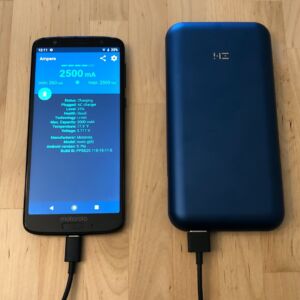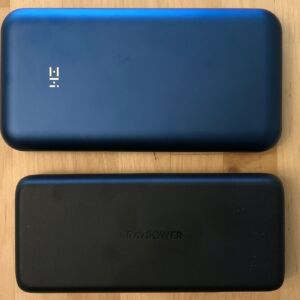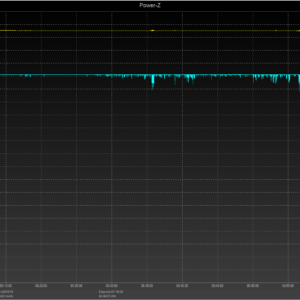ZMI PowerPack 20K Pro - A worthy successor to the ZMI PowerPack 20000 (QB820)
Summary
The ZMI PowerPack 20K Pro improves upon the ZMI PowerPack 20000 (QB820). While keeping elements which worked well. It has the same general design and enclosure. But all new electronics and lithium cells. Made to maximize output while minimizing temperature and throttling.
Overall
-
Performance
(4.5)
-
Design
(5)
-
Safety
(4.5)
-
Recharge Time
(5)
User Review
( votes)Pros
- Fast charges iPhone, Samsung Galaxy, Google Pixel, LG, and Motorola phones
- Charges Switch in both handheld and TV mode
- Can be recharged by Nintendo Switch AC Adapter
- Fits in most Switch carrying cases, but takes up most of the accessory pocket
- Charges a 12 to 14-inch laptop
- Trickle charge mode for small accessories
- USB hub function for laptops and USB-A accessories
- Supports pass through charging
- Includes a USB-C to USB-C cable
- Includes a USB-C to USB-A cable for Quick Charge devices
- Charge three devices at once with fast charging on USB-C
- Within FAA limits for lithium batteries and flights
Cons
- Can’t use USB-C PD and Quick Charge at the same time
Disclosure: As an Amazon Associate I earn from qualifying purchases. ZMI provided the product in this review.
Model: QB823
Tech Specs:
- Ports: USB-C, USB-A x2
- USB-C Output:
- 65W USB-C Power Delivery 3.0 (5V/3A, 9V/3A, 12V/3A, 15V/3A, 20V/3.25A)
- PPS 5-11V/4A
- Apple 2.4A
- USB-A Output:
- 18W Quick Charge 3.0
- Samsung Adaptive Fast Charging
- Huawei FCP
- Apple 2.4A
- Input: 45W USB-C PD (5V/3A, 9V/3A, 12V/3A, 15V/3A, 20V/2.25A)
- Capacity: 20,000mAh | 72Wh
- Size: 6.3 x 3.2 x 0.8 inches | 160 x 82 x 21 mm
- Weight: 15.5 oz | 440 grams
Learn more about Fast Charging.
Included In Box:
- ZMI PowerPack 20K Pro
- USB-C to USB-C 2.0 cable (5A/100W rated), 20 inches
- USB-C to USB-A 2.0 cable (56k Ohm resistor), 12 inches
- Travel pouch
Good For:
- Commute
- Travel
- iPhone
- Android
- Nintendo Switch (handheld & docked)
- iPad Pro
- 12-inch laptop
- 13-inch/14-inch laptop
- 15-inch laptop
Estimated Number of Charges:
- iPhone 6/7/8: 6.5 charges
- iPhone Plus/X/XR: 4 charges
- Samsung Galaxy S8/S9: 4 charges
- iPhone 11, Samsung Galaxy S10: 3.3 charges
- Nintendo Switch (2017): 9 hours of play
- Nintendo Switch (2019): 13 hours of play
- Nintendo Switch Lite: 13 hours of play
First Impression
The ZMI PowerPack 20K Pro looks a lot like the ZMI PowerPack 20000 (aka QB820). Which has been a favorite power bank of mine. I’m happy to say the Pro kept the same enclosure. And improved upon the coloring, especially with their logo. I’ll be able to tell the two power banks apart at a glance. The ports, buttons, and LED indicators are also the same. With the addition of a blue LED, used for trickle charge and USB hub modes.
The internals is all new. ZMI reports a redesign of the printed circuit board. They swapped LG lithium cells found in the non-Pro model with a higher grade of Samsung cells. And rearranged the cells to reduce heat. Pass-through charging and the USB function are the same. But trickle charge mode and PPS supply are new. And of course 20W more potential output.
The included travel pouch is the same. And still fits the power banks and both included USB cables. Add a Lightning cable and you’re all set for any phone or device.
Compared To Similar Power Banks
| Charger | ZMI PowerPack 20K Pro | RAVPower PD Pioneer 20000 60W | ZMI PowerPack 20000 Review |
| Ports | USB-C, USB-A x2 | USB-C, USB-A | USB-C, USB-A x2 |
| Output | 65W USB-C PD w/PPS Quick Charge 3.0 | 60W USB-C PD Quick Charge 3.0 | 45W USB-C PD Quick Charge 3.0 |
| Capacity | 20,000mAh | 20,000mAh | 20,000mAh |
| Features | Programmable power supply Pass Through Charging Trickle Charge Mode USB Hub | Pass Through Charging | Pass Through Charging USB Hub |
| Cable | USB-C to USB-C cable (5A/100W rated) | USB-C to USB-C cable | USB-C to USB-C cable |
| Dimensions | 6.3 x 3.2 x 0.8 in 15.5 oz | 6 x 2.6 x 1 in 13.2 oz | 6.3 × 3.2 × 0.8 in 14.3 oz |
| Price | $89.95 | No products found. | Price not available |
Prices are from Amazon Product Advertising API, last updated on 2024-04-27.
You can see more USB-C power banks here.
Device Testing
Check with your device’s manufacturer to verify which charging standards it supports.
USB Power Delivery & Quick Charge 4+ Phones
- Apple iPhone 8/X/XR/XS/11
- Essential Phone
- Google Pixel
- LG ThinQ/V30
- Razer
- Samsung Galaxy S8/S9/S10
- Samsung Galaxy Note 8/9
- Xiaomi Mi 8/9
- ZTE Axon Pro 9/10
Using an iPhone 8 for testing we find USB PD phones will fast charge over the USB-C port. iPhones will need to use a USB-C to Lightning cable, not included. And Android phones will need a USB-C to USB-C cable, which is included.
For iPhones, the USB-C and USB-A ports also support Apple 2.4A. An older, but still functional fast-charging standard. Older iPhones (4-7) can fast charge using USB-A and their regular Lightning cable. Newer iPhones will charge ~15 minutes faster using USB-C.
Quick Charge 3.0 Phones
- HTC
- LG
- Motorola
- Nokia
- Samsung Galaxy
- Sony
- Xiaomi Mi 5/6
- ZTE
Using a Moto G6 for testing we see Quick Charge will fast charge over either USB-A port. Any QC supporting Android phone with USB-C can use the included USB-C to USB-A cable.
The USB-C port will support normal charging. But it is slower than what I normally see. I saw 8W instead of the normal 9-10W.
Note you can only get Quick Charge if using only one USB-A, and not the USB-C port. If two or more ports are in use QC is disabled.
Nintendo Switch
Works well for all model Nintendo Switch in handheld/tabletop mode.
- Nintendo Switch (original) – Charges near its max rate while playing and sleeping.
- Nintendo Switch (2019 update) – Charges near its max rate while playing and sleeping.
- Nintendo Switch Lite – Charges near its max rate while playing and sleeping.
It also supports the Switch’s dock. Providing enough power for video output to your TV.
Learn more about charging the Switch.
USB-C Laptops
Using a 13-inch MacBook Pro for testing we can draw up to 55W from this charger. That’s expected, after accounting for efficiency loss. The current output was very consistent over time. Using up an entire charge of the power bank I didn’t see a significant drop in the current until the last 5 minutes of charging.
Different model laptops have different power demands. But in general, a 65W charger can support up to 13-inch/14-inch laptops under any condition. It can also support a 15-inch laptop under light use. Or charge it while sleeping.
For laptops that support 65W or greater power draw, you’ll need to use the included USB-C cable. To get that extra 5W out of this charger.
Limited Fast Charging With Two or More Devices
With two or more devices connected the USB-C output drops to 45W. And the two USB-A ports share 15W (each gets 5V and they split 3A). Which also disabled Quick Charge.
This is actually a pretty good multi-device output setup. Granted you can’t get both USB PD and Quick Charge at the same time. But some other options disable all fast charging when two or more USB ports are in use. Here the USB-C port maintains its 5-20V range and only lowers its current (amps). To support two fast-charging devices with a power bank adds size, weight, and cost.
Most smaller devices on the USB-A ports will revert to their normal charging rate. Which will continue to charge the battery while they are in use. The total charge time for the two devices is about the same. Whether you fast charge them one at a time. Or charged them at a slower rate together. Charging three devices is pushing the unit, though supported.
When you disconnect devices from the USB-A port you may want to reset the USB-C connection. In my testing, it did not automatically go back to its 65W output. If plugged into a laptop it is worth a quick unplug and replug to get the extra charging speed back.
PPS – Programmable Power Supply
Programmable power supply (PPS) protocol was added in USB Power Delivery 3.0. But not all PD 3.0 devices and chargers support it. In fact, it is uncommon now but will grow in use. It allows for small, step-wise changes in voltage and current. This reduces conversion loss during charging. The power transfer is more efficient and lithium batteries endure less heat.
Under PPS charging occurs in two phases. In the first phase, the current (amps) is constant, with a gradual increase in voltage. In the second phase, the voltage (now at a higher state) is constant, with a gradual decrease in current.
Devices that support PPS include:
- LG G7/G8 ThinQ
- LG V40/V50 ThinQ
- Razer Phone
- Samsung Galaxy S10 5G/A70
- Samsung Galaxy Note 10/10+
- Xiaomi Mi 8/9
Any device that supports Quick Charge 4+ will also support PPS. If your phone was released in 2018 or later you can check its specs to see if PPS is supported.
If your devices don’t support PPS this tech will not affect charge performance. And with this model, you’ll be future-proofed for a future PPS device.
Pass-Through Charging
Pass-through charging allows a portable charger to both charge itself and a connected device. The power received from the wall charger splits. Some to the portable charger’s own batteries. And some to the connected device. How it handles the split varies. And there are more inefficiencies than normal.
This portable charger supports pass-through charging under these connections:
- Input: USB-C, Output: USB-A
- One USB-A Port: 18W Quick Charge is available
- Two USB-A Ports: 15W shared between both ports, no fast charging
Pass-through charging is useful when you only have one USB wall charger. But it is not recommended to use this feature regularly. It puts more heat and stress on the portable charger. Which will affect its lifespan. It can also provide an inefficient charge to your device. Again, not great for its own battery’s lifespan.
If you like to have the option when traveling, fine. But don’t set this up next to your bed at home every night.
Trickle Charge Mode
Trickle charge mode is for low-power devices. Such as a Fitbit or wireless earbuds. These small accessories draw little current (<60mA). So much so a power bank thinks charging is complete, and shutdowns to save power. This means a low power draw device could get only minutes of charging.
Trickle charge mode corrects for this, by forcing the power bank to stay on for a couple of hours. Allowing small accessories time to charge.
For ZMI’s power bank you double press the side button. A blue LED will turn on separate from the four, smaller white LEDs. After two hours the power bank will switch back to regular mode. And then shut down if no charging is detected. There’s no harm in allowing the power bank to stay in trickle charge mode for the full duration. And it doesn’t affect how much power it can output.
USB Hub Function
The USB hub function in the ZMI PowerPack 20K Pro allows you to use the power bank to connect USB-A devices to your USB-C laptop. This is normally done using a separate USB-C to USB-A adapter.
Using the Hub Function
- Connect the ZMI PowerPack 20K Pro to your laptop via USB-C.
- Press the side button on the power bank twice, turning on the blue light. This is the same as turning on trickle charge mode.
- Connect your USB-A accessory to one of the two USB-A ports on the ZMI PowerPack 20K Pro.
- The accessory will appear connected to the laptop.
USB Data Transfer Rates
I tested the hub function with a USB 2.0 flash drive and a USB 3.0 flash drive. The hub function itself only supports USB 2.0. The flash drives came up promptly once connected to the power bank and the side button was pressed twice. I then tested read/write speeds against an Apple USB-C to USB Adapter.
As you can see, the Apple adapter reads data faster. With the USB 2.0 flash drive, the difference is significant, but not severe. With the USB 3.0 flash drive, you can see the USB 2.0 supports only the bottleneck of the power bank. If you often use a USB-C to USB adapter and every Mbps counts, then keep your current adapter. But for emergency use only you could consider leaving the dongle at home. And relying on the usable, if slower USB hub function of your power bank.
When done with the USB hub function you’ll need to press the side button once to turn it off. Otherwise, the power will remain on in that mode for up to two hours. Not a significant power drain. But a drain nonetheless.
USB-C Cable with 5A/100W Support
The USB-C to USB-C cable ZMI includes is necessary for the portable charger to reach its greatest potential. The cable includes an eMarker and supports 5A current, allowing for up to 100W.
Most USB-C cables are only rated for 3A current. Limiting them to 60W power throughput. When a charger offering more than 20V/3A (65-100W) connects it checks the cable for an eMarker. The eMarker tells the charger about the cable’s capabilities. Such as increased power throughput. If it doesn’t detect an eMarker, then the charger assumes the cable is only rated for 3A current. In this case, the charger will then only offer up to 60W.
So if you connect most any other USB-C cable you have to this portable charger it’ll limit itself to 60W. That’s fine if your device only draws 60W or less. But if you want the full 65W you’ll need to use the included cable. Or another USB-C cable you know allows for 5A/100W. I recommend marking ZMI’s cable with colored tape or by some other means. So you know it should remain paired with its charger.
Summary
The ZMI PowerPack 20K Pro is an upgrade over the ZMI PowerPack 20000. Higher potential output, PPS support, and trickle charge support. All in the same enclosure and without a significant temperature increase.
The USB-C port will fast charge iPhone 8/X/XR/XS/11, Samsung Galaxy, and Google Pixel under any conditions. And either USB-A port will fast charge LG, Motorola, and other Quick Charge phones. But only if the phone is the only connected device. The inclusion of PPS helps future proof it against future Samsung Galaxy models.
For the Nintendo Switch, it charges in handheld mode as fast as any other option. And can power a docked Switch. Regardless of whether the USB-A ports are in use or not.
It can provide full power to most 13 and 14-inch laptops with USB-C. Using the included USB-C cable it can offer up to 75% of the max draw rate a 15-inch MacBook Pro may demand. There is no output drop off until the last few minutes of battery life. Meaning it’ll charge as fast as possible up until the end.
The power bank’s own input remains at 45W, like the non-pro version. That’s a good rate for a 20,000mAh capacity, recharging in ~3 hours. But being able to recharge it as fast as it can output would be nice.
This isn’t a budget power bank and it includes a lot of bells and whistles. Few known brands offer 60-65W output. PPS support is rare, and more devices are coming out to support it. Trickle charge/USB hub mode is good for those with watches and fitness devices. Or laptops with USB-A accessories. It is worth the price if you need some or all these features.
About ZMI
ZMI USA has U.S. based support (web, email, phone) and an 18-month warranty. They were founded in the USA and are backed financially by Zimi Corporation. Zimi is the exclusive mobile power accessory supplier to Xiaomi.
Bottom Line
The ZMI PowerPack 20K Pro is a high-end power bank. Offering 65W USB-C PD output with PPS support, Quick Charge, trickle charge, and more. And includes everything you need, except for a wall charger. For a laptop or future-proofing, they don’t get better than this. It isn’t a budget level power bank. You’ll pay a fair price for all these features.
Buy if you:
- Want one power bank for all your devices, including a laptop
- Have a newer Samsung phone supporting PPS, or will be getting a new Samsung phone in the next year or two
- Need as much output as you can get from a proven brand
Don’t buy if you:
- Don’t own a laptop with USB-C, or expect to in the future
- Are more concerned with highest possible capacity than faster output
You’ll want a USB-C wall charger to quickly recharge this USB-C power bank. I recommend the ZMI zPower Turbo 65W USB-C PD. It has the same output as the power bank, making it equally good for the same USB-C devices.
Be sure to check the Deals page to see if this or a similar charger is on sale.
Enjoyed this review? Sign up for the Switch Chargers newsletter and get updates on future reviews and Nintendo Switch related deals.

































